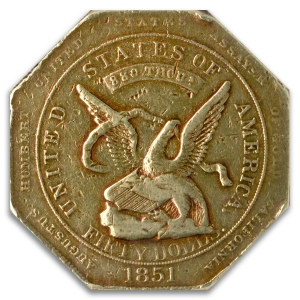4 Questions for Coin Collectors
Posted on — 1 CommentPart of the fun of coin investing is the rich history that comes along with each unique coin.

- Who touched that coin?
- What was that coin used to purchase in 1909?
- Why are certain markings on different coins?
If you have been amassing your coin portfolio for some time, you may already know the answers to these questions. Just for fun, let’s test your coin IQ here. Dive in! Let us know your favorite fact about coins below!
- Name four foreign governments that the U.S. Mint forged coins for in 1944?
Answer: In the midst of WWII, the U.S. Mint produced roughly 800,000,000 coins for friendly nations amidst the pressures and demands for coins during war time. The U.S. Mint forged coins for:
- Ethiopia
These coins (four copper and one silver) featured the likeness of Emperor Haile Selassie, who refused to bow to Benito Mussolini.
- Greenland
The U.S. Mint produced copper kroners featuring the traditional polar bear seen on earlier Danish coins.
- Saudi Arabia
For the Arab nation, the U.S. Mint created silver riyals with intricate tracings.
- France
The Philadelphia Mint struck Franc coins made from melted down shell cases.
A little history: In 1874, the Mint was authorized to manufacture coins for foreign governments, but during WWII that production hit historic proportions. Foreign nations faced an acute shortage of coins, just as demand escalated for coins amid the presence of large numbers of allied troops.
The list of countries for which the United States made coins from 1940 to 1945 as part of a Good Neighbor policy includes Australia, Belgian Congo, Belgium, Bolivia, Cuba, Curacao, Dominican Republic, Ecuador, El Salvador, Ethiopia, Fiji Islands, France, Greenland, Guatemala, Indo-China, Liberia, Netherlands and her island possessions, Nicaragua, Peru, Philippine Islands, Saudi Arabia, and Surinam.
- What is the only circulating coin in which the portrait faces to the right?
Answer: The Lincoln penny.
- The likeness of President Lincoln is an adaption of a plaque by Victor David Brenner, a well-known sculptor and artist of the time. President Theodore Roosevelt was so taken by Brenner’s portrait of Lincoln that he recommended to the Secretary of the Treasury that the design be struck on a new coin issued in the Lincoln Centennial Year, 1909.
- The 1909 Lincoln cent replaced the Indian head penny.
- In 1959 the Lincoln Memorial was added to the back of the coin.
- Why was the small eagle added to the Benjamin Franklin Half Dollar?
Answer: The U.S Mint struck the Franklin half dollar from 1948 to 1963. The half dollar features Benjamin Franklin on the obverse and the Liberty Bell on the reverse. A tiny eagle was added to the right of the Liberty Bell in order to satisfy the legal requirement that half dollars include a representative of an eagle.
The Franklin half dollar and the Roosevelt dime were both designed by John R. Sinnock, and his initials appear below the shoulder.
- When did the Philadelphia Mint first add its mint mark to a coin?
Answer: During WWII nickel was removed from 5-cent coins. In 1942, the mint mark moved from the right of Monticello to above the dome to signify the substituted alloy. It was at this time that the Philadelphia Mint first struck “P” on coins forged in Philadelphia.
The practice of striking mint marks dates back to ancient Greece and Rome. In 1835, the practice began in the United States, as the nation’s growing economy demanded a fresh influx of coins. Early mints included:
- In 1838, the New Orleans mint opened (O).
- In 1838, the Dahlonega, Georgie (D) mint opened. It closed in 1861.
- In 1854, the San Francisco Mint (S) opened.
- In 1870, the Carson City, Nevada (CC) mint opened. It closed in 1893.
- In 1906, the Denver Mint (D) opened.
- In 1984, the West Point, New York (W) mint opened.
What’s Your Coin IQ?
What is the most interesting fact you’ve learned about coins during your time as a collector? Leave a comment below!
See Blanchard’s current rare coin inventory here. For serious collectors, we have tremendous reach and respect within the rare coin industry. If there is a particular coin or set that you are trying to build, our numismatists can help source your coins from collections around the world.
1 thought on “4 Questions for Coin Collectors”
Comments are closed.








It’s good to know that half dollars need a representative of an eagle on it. My uncle loves collecting coins and I want to get him a unique one for his birthday this weekend. I’ll have to find ones that he doesn’t have to see if any coin dealers have what I’m looking for.